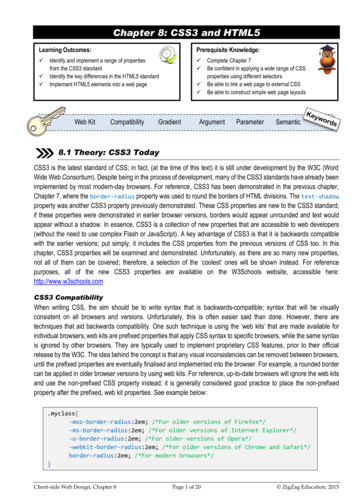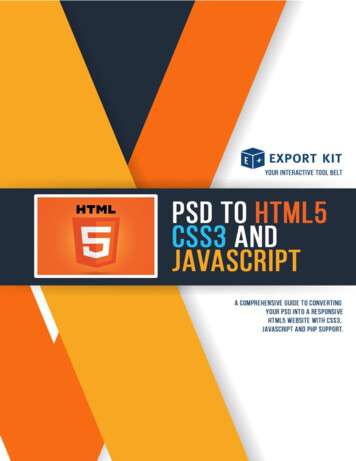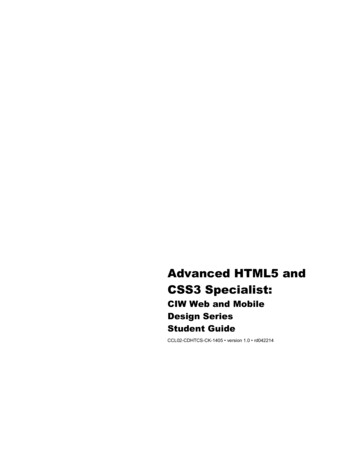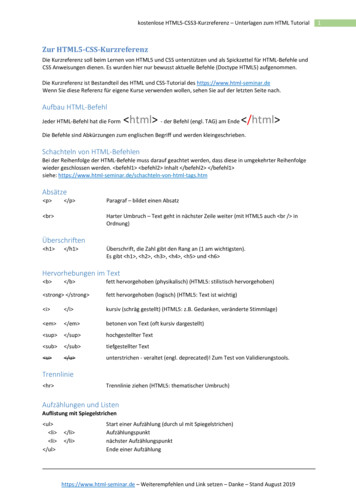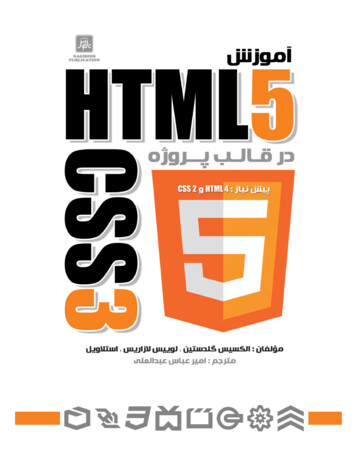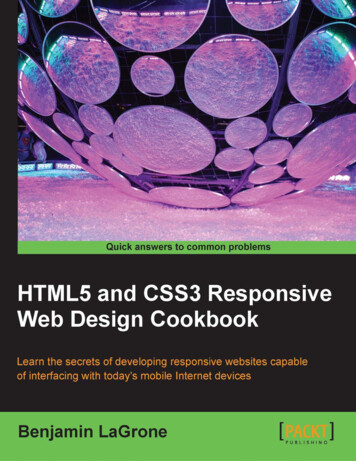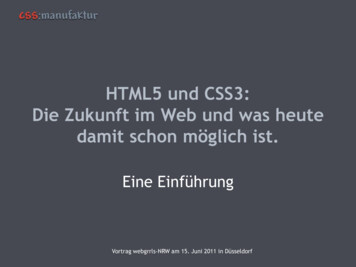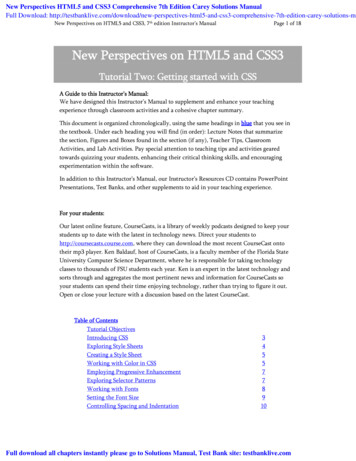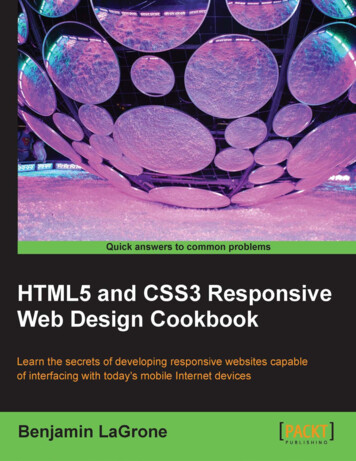
Transcription
HTML5 and CSS3Responsive WebDesign CookbookLearn the secrets of developing responsive websitescapable of interfacing with today's mobile Internet devicesBenjamin LaGroneBIRMINGHAM - MUMBAI
HTML5 and CSS3 Responsive Web DesignCookbookCopyright 2013 Packt PublishingAll rights reserved. No part of this book may be reproduced, stored in a retrieval system,or transmitted in any form or by any means, without the prior written permission of thepublisher, except in the case of brief quotations embedded in critical articles or reviews.Every effort has been made in the preparation of this book to ensure the accuracy of theinformation presented. However, the information contained in this book is sold withoutwarranty, either express or implied. Neither the author, nor Packt Publishing, and its dealersand distributors will be held liable for any damages caused or alleged to be caused directlyor indirectly by this book.Packt Publishing has endeavored to provide trademark information about all of the companiesand products mentioned in this book by the appropriate use of capitals. However, PacktPublishing cannot guarantee the accuracy of this information.First published: May 2013Production Reference: 1160513Published by Packt Publishing Ltd.Livery Place35 Livery StreetBirmingham B3 2PB, UK.ISBN 978-1-84969-544-2www.packtpub.comCover Image by Duraid Fatouhi (duraidfatouhi@yahoo.com)
CreditsAuthorBenjamin LaGroneReviewersDale CruseProject CoordinatorArshad SopariwalaProofreaderAmy GuestEd HendersonRokesh JankieAcquisition EditorEdward GordonLead Technical EditorsSavio JoseNeeshma RamakrishnanTechnical EditorsIshita MalhiHardik SoniNitee ShettyIndexerTejal R. SoniProduction CoordinatorNitesh ThakurCover WorkNitesh Thakur
About the AuthorBenjamin LaGrone is a web developer who lives and works in Texas. He got his start inprogramming at the age of 6 when he took his first computer class at The Houston Museumof Natural Science. His first program was “choose your own adventure book”, written in BASIC;he has fond memories of the days when software needed you to write line numbers.Fast forward to about thirty years later; after deciding that computers are here to stay,Ben has made a career combining some of his favorite things—art and coding; creatingart from code. One of his favorite projects was using the GMaps API to map pathologies tochromosomes for cancer research.Fascinated with mobile devices for a long time, Ben thinks that the Responsive Web is one ofthe most exciting, yet long time coming, new aspects of web development. He now works in aSAAS development shop and is the mobile and Responsive Web evangelist for the team.When he’s not working on some Internet project, Ben spends his time building robots,tinkering with machines, drinking coffee, surfing, and teaching Kuk Sool martial arts.This book could not have been written without the patience and support ofmy loving wife, Hannah, and my two beautiful daughters, Daphne and Darby.Thank you.
About the ReviewersDale Cruse is the author of HTML5 Multimedia Development and has worked as atechnical editor on several other HTML5 books. He started his career in 1995 as a U.S.Army photojournalist. Since going purely digital on CBSNews.com, he’s created web andmobile experiences for some of the most well-known clients in the world, including 20thCentury Fox, Bloomingdale’s, and MINI Cooper. Currently, he juggles between being a seniorfrontend developer at Allen & Gerritsen and a New York Yankees fan in South Boston. Anin-demand speaker, you can’t get him to shut up on Twitter at @dalecruse.Ed Henderson was born and raised in Scotland, and is an experienced human being,with a love for designing, building, and making and breaking things online.Not afraid to get his hands dirty and his feet wet, he is open to new technologies as longas they are useful and/or fun.Ed has a real degree in Computer Science, has run his own business, worked freelance,been employed, and been a consultant. He is now employed as Senior Software Engineerfor POPSUGAR in San Francisco, California, USA.He has vast experience in all aspects of the industry, from web pages and apps to socialmedia. Ed has also reviewed and written a number of books.Ed thrives on coming up with fresh ideas. Making a difference and turning one of thoseideas into useful, working “things” is what floats Ed’s boat.
Away from the crazy world of the Web, Ed has run the Edinburgh Marathon and abseileddown a lighthouse, raising thousands of pounds for charity. He captained his local Scottishrugby team for three seasons, winning the championship as top scorer and reaching thefinal of a national competition.You may not know that Ed is the Dad from Jack Draws Anything(http://jackdrawsanything.com/) and the winner of the prestigious .netmagazine Social Campaign of the Year (2011) award.Ed lives in Corte Madera, California, USA (just 15 minutes from San Francisco) with therest of Team Hendo: his amazing wife Rose and sidekicks Jack, Toby, and Noah.Ed likes cake, bacon, cider, and talking about himself in the third person.Rokesh Jankie graduated with a Masters degree in Computer Science from LeidenUniversity, the Netherlands, in 1998. His field of specialization was Algorithms andNP-complete problems. Scheduling problems can be NP-complete, and that’s the area hefocused on. After that, he started working for the University of Leiden. He then went on towork with ORTEC consultants, Ponte Vecchio, and later, with Qualogy. At Qualogy, he usedhis experience thus far to set up a product. Qualogy works in the fields of Oracle and Javatechnologies. With the current set of technologies, interesting products can be delivered;that is QAFE (see www.qafe.com for more info).The company that he works for now is specialized in Oracle and Java technologies. As head ofthe product development department and CTO of QAFE Inc., his focus is on the future of webapplication development. At the company, modern technologies (such as HTML5, Google APIs,AngularJS, NodeJS, and Java) are used, and close contact is kept with some excellent peopleat Google to make things work.He has also reviewed the books HTML5 Canvas Cookbook by Packt Publishing and Dart inAction by Manning Publications Co.I’m very honored and grateful that I was contacted to review this book. SavioJose gave me the opportunity to review the book. It always feels good to bepart of the next big thing on the Web (HTML5, CSS3, and JavaScript) in thisway and for this particular topic. The future of web applications looks verypromising.
www.PacktPub.comSupport files, eBooks, discount offers and moreYou might want to visit www.PacktPub.com for support files and downloads related toyour book.Did you know that Packt offers eBook versions of every book published, with PDF and ePubfiles available? You can upgrade to the eBook version at www.PacktPub.com and as a printbook customer, you are entitled to a discount on the eBook copy. Get in touch with us atservice@packtpub.com for more details.At www.PacktPub.com, you can also read a collection of free technical articles, sign up fora range of free newsletters and receive exclusive discounts and offers on Packt books andeBooks.http://PacktLib.PacktPub.comDo you need instant solutions to your IT questions? PacktLib is Packt’s online digital booklibrary. Here, you can access, read and search across Packt’s entire library of books.Why Subscribe?ffFully searchable across every book published by PacktffCopy and paste, print and bookmark contentffOn demand and accessible via web browserFree Access for Packt account holdersIf you have an account with Packt at www.PacktPub.com, you can use this to access PacktLibtoday and view nine entirely free books. Simply use your login credentials for immediate access.
Table of ContentsPrefaceChapter 1: Responsive Elements and MediaIntroductionResizing an image using percent widthResponsive images using the cookie and JavaScriptMaking your video respond to your screen widthResizing an image using media queriesChanging your navigation with media queriesMaking a responsive padding based on sizeMaking a CSS3 button glow for a loading elementChapter 2: Responsive TypographyIntroductionCreating fluid, responsive typographyMaking a text shadow with canvasMaking an inner and outer shadow with canvasRotating your text with canvasRotating your text with CSS3Making 3D text with CSS3Adding texture to your text with text maskingStyling alternating rows with the nth positional pseudo classAdding characters before and after pseudo elementsMaking a button with a relative font sizeAdding a shadow to your fontCurving a corner with border radius1556810131419212727282931333436383941424446
Table of ContentsChapter 3: Responsive Layout49Chapter 4: Using Responsive Frameworks79IntroductionResponsive layout with the min-width and max-width propertiesControlling your layout with relative paddingAdding a media query to your CSSCreating a responsive width layout with media queriesChanging image sizes with media queriesHiding an element with media queriesMaking a smoothly transitioning responsive layoutIntroductionUsing the Fluid 960 grid layoutUsing the Blueprint grid layoutFluid layout using the rule of thirdsTrying Gumby, a responsive 960 gridThe Bootstrap framework makes responsive layouts easy4949525559646668798084889399Chapter 5: Making Mobile-first Web Applications105Chapter 6: Optimizing Responsive Content139IntroductionUsing the Safari Developer Tools' User Agent switcherMasking your user agent in Chrome with a pluginUsing browser resizing pluginsLearning the viewport and its optionsAdding tags for jQuery MobileAdding a second page in jQuery MobileMaking a list element in jQuery MobileAdding a mobile, native-looking button with jQuery MobileAdding a mobile stylesheet for mobile browsers only using media queriesAdding JavaScript for mobile browsers onlyIntroductionResponsive testing using IE's Developer ToolsBrowser testing – using pluginsDevelopment environments – getting a free IDEVirtualization – downloading VirtualBoxGetting a browser resizer for 149152156
Table of ContentsChapter 7: Unobtrusive JavaScript161Index185IntroductionWriting "Hello World" unobtrusivelyCreating a glowing "submit" button with the event listenerMaking a button stand out when you hover over itResizing an element with unobtrusive jQueryMasking a password with unobtrusive JavaScriptUsing an event listener to animate an image shadow161161165169173177179iii
Table of Contentsiv
PrefaceHTML5 and CSS3 Responsive Web Design Cookbook gives developers a new toolbox forstaying connected with this new skillset. Using the clear instructions given in the book, youcan apply and create responsive applications and give your web project the latest design anddevelopment advantages for mobile devices. Using real-world examples, this book presentspractical how-to recipes for site enhancements with a lighthearted, easy-to-understand tone.Gain a real understanding of Responsive Web Design and how to create an optimized displayfor an array of devices. The topics in this book include responsive elements and media,responsive typography, responsive layouts, using media queries, utilizing modern responsiveframeworks, developing mobile-first web applications, optimizing responsive content, andachieving unobtrusive interaction using JavaScript and jQuery. Each recipe features actuallines of code that you can apply.What this book coversChapter 1, Responsive Elements and Media, covers the creation of elements that optimizeto mobile devices or desktop computers.Chapter 2, Responsive Typography, teaches you about using fluid typography, creating cooltext effects, and creating text that stands out on your screen through the HTML5 canvasand CSS3.Chapter 3, Responsive Layout, teaches you how to create responsive layouts that you canreally use in your projects. You will learn about using viewport and media queries to makeyour web project respond to different viewport sizes and types.Chapter 4, Using Responsive Frameworks, teaches you how to use new frameworks to deployresponsive sites with the latest responsive methods and interactions quickly and reliably, andhow to turn old static frameworks into responsive ones.Chapter 5, Making Mobile-first Web Applications, teaches you how to make mobile webversions of your web application, which are optimized to be mobile-first, with jQuery Mobile,and how to optimize for the desktop viewport.
PrefaceChapter 6, Optimizing Responsive Content, teaches you about getting and using all the toolsyou need to build and test your responsive web project.Chapter 7, Unobtrusive JavaScript, teaches you how to write JavaScript that lives out of yourweb page so that you can have thoughtful, responsive interactions for different devices.What you need for this bookYou will need an IDE (integrated development environment); NetBeans or Eclipse isrecommended (there are instructions on how to get one inside), image editing software suchas Photoshop or GIMP, a web host, and a local web server such as Apache or a local hostingapplication such as XAMPP or MAMPP.Who this book is forThis book, for all of today’s wireless Internet devices, is for web developers seeking innovativetechniques that deliver fast, intuitive interfacing with the latest mobile Internet devices.ConventionsIn this book, you will find a number of styles of text that distinguish between different kinds ofinformation. Here are some examples of these styles, and an explanation of their meaning.Code words in text, database table names, folder names, filenames, file extensions,pathnames, dummy URLs, user input, and Twitter handles are shown as follows: “ Theheight: auto property acts to preserve the aspect ratio of the image.”A block of code is set as follows: p class ”text” Loremipsum dolor sit amet /p div class ”img-wrap” img alt ”robots image” class ”responsive” src ”robots.jpg” p Loremipsum dolor sit amet /p /div When we wish to draw your attention to a particular part of a code block, the relevant lines oritems are set in bold: !DOCTYPE HTML html head style .rotate {/* Chrome, Safari 3.1 */-webkit-transform: rotate(-90deg);2
Preface/* Firefox 3.5-15 */-moz-transform: rotate(-90deg);/* IE9 */-ms-transform: rotate(-90deg);/* Opera 10.50-12*/-o-transform: rotate(-90deg);/* IE */transform: rotate(-90deg);} /style /head body p class ”rotate” I think, therefore I am /p /body /html New terms and important words are shown in bold. Words that you see on the screen, inmenus or dialog boxes for example, appear in the text like this: “However, what I really want isa large image, so I click on Search tools, and then on Any Size, which I change to Large.”.Warnings or important notes appear in a box like this.Tips and tricks appear like this.Reader feedbackFeedback from our readers is always welcome. Let us know what you think about this book—what you liked or may have disliked. Reader feedback is important for us to develop titles thatyou really get the most out of.To send us general feedback, simply send an e-mail to feedback@packtpub.com, andmention the book title via the subject of your message.If there is a topic that you have expertise in and you are interested in either writing orcontributing to a book, see our author guide on www.packtpub.com/authors.Customer supportNow that you are the proud owner of a Packt book, we have a number of things to help you toget the most from your purchase.3
PrefaceDownloading the example codeYou can download the example code files for all Packt books you have purchased from youraccount at http://www.packtpub.com. If you purchased this book elsewhere, you canvisit http://www.packtpub.com/support and register to have the files e-mailed directlyto you.ErrataAlthough we have taken every care to ensure the accuracy of our content, mistakes do happen.If you find a mistake in one of our books—maybe a mistake in the text or the code—we would begrateful if you would report this to us. By doing so, you can save other readers from frustrationand help us improve subsequent versions of this book. If you find any errata, please report themby visiting http://www.packtpub.com/submit-errata, selecting your book, clicking onthe errata submission form link, and entering the details of your errata. Once your errata areverified, your submission will be accepted and the errata will be uploaded on our website, oradded to any list of existing errata, under the Errata section of that title. Any existing errata canbe viewed by selecting your title from http://www.packtpub.com/support.PiracyPiracy of copyright material on the Internet is an ongoing problem across all media. At Packt,we take the protection of our copyright and licenses very seriously. If you come across anyillegal copies of our works, in any form, on the Internet, please provide us with the locationaddress or website name immediately so that we can pursue a remedy.Please contact us at copyright@packtpub.com with a link to the suspected pirated material.We appreciate your help in protecting our authors, and our ability to bring you valuable content.QuestionsYou can contact us at questions@packtpub.com if you are having a problem with anyaspect of the book, and we will do our best to address it.4
1Responsive Elementsand MediaIn this chapter, you will learn about:ffResizing an image using percent widthffResponsive images using the cookie and JavaScriptffMaking your video respond to your screen widthffResizing an image using media queriesffChanging your navigation with media queriesffMaking a responsive padding based on sizeffMaking a CSS3 button glow for a loading elementIntroductionThe responsiveness website design and media is one of the most exciting things to happento web development since ASCII art appeared on bulletin boards back when I was a schoolboy. The new cool features of HTML5, CSS3, and jQuery have brought new life to the old webin ways that have brought back the fun and really gets the Web audiences excited for usingyour applications. This chapter contains several recipes that will help you create responsiveHTML elements and different media.Some recipes are easy and some are more challenging. All of the code used for theresponsive web design elements is provided inside the book, therefore nothing insidewill be impossible to accomplish. Each and all of the responsive web design recipes willhelp you optimize your website's presentation to create an amazing responsive webexperience for your audience no matter what device type or size you are using.
Responsive Elements and MediaResizing an image using percent widthThis method relies on client-side coding for resizing a large image. It serves only one imageto the client and asks it to render the image according to the size of the browser's window.This is usually the preferable method when you are confident that the clients have thebandwidth to download the image without causing the page to load slowly.Getting readyFirst you will need an image. To find a high-quality image, use Google Image Search.A search for robots, for example, the search gives me 158,000,000 results, which ispretty good. However, what I really want is a large image, so I click on Search tools, and thenclick on Any Size, which I change to Large. I still have 4,960,000 images to choose from.The image should be resized to match the largest scale viewable. Open it in your image-editingsoftware. If you don't have an image-editing software already, there are many free ones, goget one. Gimp is a powerful image-editing software and it's open source, or free to download.Go to http://www.gimp.org to get this powerful open source image-editing software.How to do it Once you have your image-editing software, open the image in it and change theimage's width to 300px. Save your new image and then move or upload the imageto your web directory.Your HTML should contain your image and some text to demonstrate the responsive effect.If you do not have time to write your life story, you can go back to the Internet and get somesample text from an Ipsum generator. Go to http://www.lipsum.com and generate aparagraph of Ipsum text. p class "text" Loremipsum dolor sit amet /p div class "img-wrap" img alt "robots image" class "responsive" src "robots.jpg" p Loremipsum dolor sit amet /p /div Your CSS should include a class for your paragraph and one for your image and an imagewrapper. Float the paragraph to the left and give it a width of 60%, and the image wrapperwith a width of 40%.p.text {float:left;6
Chapter is creates a fluid layout, but does not yet do anything to create a responsive image.The image will stay at a static width of 300px until you add the following CSS. Then, add a newclass to the CSS for the image. Assign it a max-width value of 100%. This allows the widthto adjust to the browser width changes. Next, add a dynamic height property to the class.img.responsive {max-width: 100%;height: auto;}This creates an image that responds to the browser window's width with an optimized versionof that image for the audience.Downloading the example codeYou can download the example code files for all Packt books you havepurchased from your account at http://www.packtpub.com. If youpurchased this book elsewhere, you can visit http://www.packtpub.com/support and register to have the files e-mailed directly to you.How it works The responsive property of the image CSS forces it to take 100 percent of its parentelement. When the parent element's width changes, the image changes to fill in thatwidth. The height: auto property acts to preserve the aspect ratio of the image.See alsoffThe Responsive images using the cookie and JavaScript recipeffThe Making a responsive padding based on size recipe7
Responsive Elements and MediaResponsive images using the cookie andJavaScriptA responsive image's width can be delivered through complicated server logic. Sometimesbecause of the requirements you cannot achieve the desired results through the easiestmethod. The percent-width method relies on the client side for image resizing of a largeimage file. This method provides a server-side delivery of the properly sized image yourequest. It may reduce the server load and bandwidth and help you with long loading,if you are concerned with slow loading affecting the performance of your website.Getting readyThese methods require your server to perform some sort of logic function on it. Firstly, itrequires PHP on your server. It also requires you to create three different sized versionsof the image and serve them to the client as requested.How to do it The JavaScript is simple. It creates a cookie based on your device's screen dimensions.When the client makes a request to the server for an image, it fires the PHP code todeliver the appropriate image. script document.cookie "screen dimensions " screen.width "x" screen.height; /script Now, on your server, create an images folder in the web directory and create a PHP file(index.php) with the following code in it: ?php screen w 0; screen h 0; img SERVER['QUERY STRING'];if (file exists( img)) {// Get screen dimensions from the cookieif (isset( COOKIE['screen dimensions'])) { screen explode('x', COOKIE['screen dimensions']);if (count( screen) 2) { screen w intval( screen[0]); screen h intval( screen[1]);}}8
Chapter 1if ( screen width 0) { theExt pathinfo( img, PATHINFO EXTENSION);// for Low resolution screenif ( screen width 1024) { output substr replace( img, '-med', -strlen( theExt)-1,}// for Medium resolution screenelse if ( screen width 800) { output substr replace( img, '-low', -strlen( theExt)-1, 0);}// check if file existsif (isset( output) &&file exists( output)) { img output;}}// return the image file;readfile( img);}? Now with your image-editing software, open your large image and create two smaller versionsof it. If the original version is 300px, then make the next two copies 200px and 100px. Then,name them robot.png, robot-med.png, and robot-low.png respectively. Upload thesethree images into the images folder.Last, but not least, put the following HTML file in your server's document root: !doctype html html head title Responsive Images /title meta charset "utf-8" script document.cookie "device dimensions " screen.width "x" screen.height; /script /head body img alt "robot image" src "images/index.php?robot.png" /body /html 9
Responsive Elements and MediaYou can see the recipe in action in the following screenshot:While this method is limited to delivering a specific image for each screen size, and is notfluidly dynamic, it does provide the same functionality on the server side as a CSS mediaquery. You can style the served image with CSS or animate it with JavaScript. It can beused with a combination of methods to provide responsive content.The code for this recipe was originally created by the clever folks at i-cookie/.How it works The HTML file first creates a cookie describing your device's screen dimensions. When theimage element calls the PHP file it works like an include statement in PHP. The PHP filefirst checks for the file to exist, then reads the cookie for the screen width, and delivers theappropriate-sized version of the image.Making your video respond to your screenwidthThe streaming of video can also be responsive. You can easily embed an HTML5 video in yourpage and make it responsive. The video tag easily supports using a percent width. However,it requires that you have the video source on your website's host. If you have this available,this is easy. style video {10
Chapter 1max-width: 100%;height: auto;} /style video width "320" height "240" controls "controls" source src "movie.mp4" type "video/mp4" source src "movie.ogg" type "video/ogg" Your browser does not support the video tag. /video However, using a video-hosting site, such as YouTube or Vimeo, has many advantages overhosting it yourself. First, there is the bandwidth issue, you may have bandwidth or disk spacelimits on your hosting server. Additionally, video-hosting sites make the upload conversion toa usable web video surprisingly easy, compared to using only your own resources.Getting readyThe video-hosting sites allow you to embed an iFrame or object code snippet in yourpage to stream the video on your site. This won't work inside the video tag. So, tomake it responsive, there is a more complex, but still easy method.How to do it Wrap the video-source snippet in an HTML containing the div element and give it a 50 to 60percent padding on the bottom and relative positions. Then give its child element, the videoiFrame object, a 100% width and 100% height, and an absolute position. This makes theiFrame object completely fill in the parent element.The following is the HTML code that uses an iframe tag to get a video from Vimeo: div class "video-wrap" iframe src "http://player.vimeo.com/video/52948373?badge 0"width "800" height "450" frameborder "0" /iframe /div The following is the HTML code using the older YouTube object with markup: div class "video-wrap" object width "800" height "450" param name "movie" value "http://www.youtube.com/v/b803LeMGkCA?version 3&hl en US" /param param name "allowFullScreen" value "true" /param 11
Responsive Elements and Media param name "allowscriptaccess" value "always" /param embed src "http://www.youtube.com/v/b803LeMGkCA?version 3&hl en US" type "application/x-shockwaveflash" width "560" height "315" allowscriptaccess "always"allowfullscreen "true" /embed /object /div Both video types use the same CSS:.video-wrap {position:relative;padding-bottom: 55%;padding-top: 30px;height: 0;overflow:hidden;}.video-wrap iframe,.video-wrap object,.video-wrap embed ou might not want the video to take up the entire width of the page. In this case, you can limitthe width of the video using width and max-width. Then, wrap the video-wrap elementwith the another div element and assign a fixed width value and max-width:100%. div class "video-outer-wrap" div class "video-wrap" iframe src "http://player.vimeo.com/video/6284199?title 0&byline 0&portrait 0" width "800" height "450" frameborder "0" /iframe /div /div .video-outer-wrap {width: 500px;max-width:100%;}This recipe will work on all modern browsers.12
Chapter 1How it works This method is called Intrinsic Ratios for Videos, created by Thierry Koblentz on A List Apart.You wrap the video inside an element that has an intrinsic aspect ratio, and then give thevideo an absolute position. This locks the aspect ratio, while allowing the size to be fluid.Resizing an image using media queriesThe media query is another useful and highly customizable method for responsive images.This is different than responsive fluid width achieved by the percent-width method. Yourdesign may require some specific image widths for different screen size ranges and afluid width would break your design.Getting readyThis method only requires one image, and makes the client's browser resize the imageinstead of the server.How to do it The HTML code is simple, using the standard image tag, create an image element, as follows: img alt "robot image" src "robot.png" To start with a simple version, create a media query that will detect the browser window'ssize and deliver a larger image for browser screens larger than 1024px, and a smaller imagefor smaller browser windows. First the media query, it looks for the media type screen, andthen the screen size. When the media query is satisfied the browser will render the CSS insidethe brackets.@media screen and ( max-width: 1024px ) { }@media screen and ( min-width: 1025px ) { }No
HTML5 and CSS3 Responsive Web Design Cookbook Learn the secrets of developing responsive websites ca
